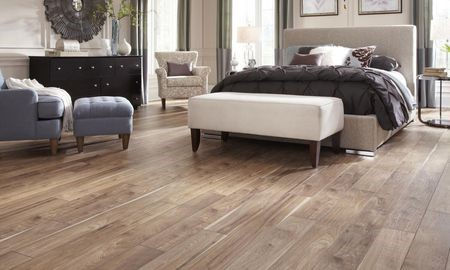In Style: Hard Finishes - LVP

A relative newcomer to the residential flooring industry is LVP: "Luxury Vinyl Plank". We've used vinyl flooring for decades in commercial applications, but with the demand for highly durable flooring for the residential market, manufacturers have restyled vinyl material and created products for the home which utilize the technology and durability of the commercial counterparts. LVP is a cost effective way to update without breaking your budget and not sacrifice style when compared to real wood flooring and porcelain tile.

LVP mimics the natural appearance of wood planks and is offered in a wide variety of natural wood colors and "species”. The surface often includes texture or embossing that has the look of scraping or natural wood grain which lends to the material's realist appearance. The styles can range from rustic, reclaimed wood looks, to clean modern, and coastal and weather-worn "beachy" looks. Just like wood, the vinyl planks can be installed in a number of patterns such as diagonally, herringbone, chevron, and parquet.


There are numerous benefits to LVP but there are also some disadvantages of which you should be aware to make the best decision on choosing this material.
First, the Pros:
1. LVP has greater comfort underfoot than porcelain tile and other hard flooring. Many include built-in, cushiony underlayments for additional comfort. It also stays room temperature, so even in winter, LVP floors will not get cold like some other types of flooring. Some LVP floors will even work with radiant heating systems.
2. It’s surprisingly attractive, highly durable and easy to maintain. Many manufacturers include specially engineered surfaces that have scratch, scuff, and stain resistance. Even permanent marker will clean easily with a mild cleaning solution. It requires no waxing, polishing, or special chemicals to maintain its appearance. It's important to follow the manufacturer's directions and read the label on the cleaning solutions, but LVP floors typically clean-up with a broom or dust mop. For deeper cleaning, a damp mop and a mild cleaner will do.

3. Vinyl flooring also absorbs noise. This makes it a good choice for second stories. With an added underlayment, LVP may meet the requirements for noise attenuation in some condominiums where noise rules are written in the association bylaws. Check with the association rules.
4. LVP can be installed in places where moisture could be a problem such as kitchens, bathrooms, laundry rooms, basements, active families, or homes with pets. This gives you the look of real wood without the worry.

Now the Cons:
1. There are some health risks to LVP. Vinyl flooring emits gasses and volatile chemicals called VOCs. Even though the government sets strict manufacturing regulations on VOC levels, there are still some reports of health issues that trace back to vinyl flooring. Vinyl flooring may not be the best flooring choice if there is someone in your home or business that has respiratory issues. Look for products that are phthalate free.

2. There could be accessibility concerns if a member of your home or business uses a wheelchair or mobility device. You may want to consider using glue down planks in this instance. Many of the floating and click in place systems are prone to shifting under rolling loads, which can cause additional hazards for those individuals.
3. There could be a minimal return on investment. Vinyl flooring will not raise the value of your home (in most cases). If it does, the effects will be minimal. Even if the installed LVP looks fantastic, many people will perceive the flooring material as being “cheap” or “low end”. Even though a coastal home may benefit from this practical flooring application, it may not raise the value of a waterfront property due to the perception of the vinyl material not being a “high end” finish.
4. Even though LVP is highly durable, it is not indestructible. LVP is not fade proof and it can also show dents and can puncture. It could scratch and fade with repeated exposure to sunlight.
Heavy furniture will leave indentations, so if you ever want to rearrange your furniture, you may have some dents to contend with. This also includes installing the material over tile or an uneven subfloor. Make sure your installer “floats” the floor, removes any old setting materials or adhesives, tack strips, and fills in any cracks prior installing your LVP to create an even surface free from imperfections that won’t transmit through the vinyl.
With most wood flooring, you can sand out scratches and re-stain faded areas. Unfortunately, with LVP, there is nothing you can do to repair scratches and fading. If a small portion of the vinyl is damaged, it’s an easy fix, so it’s always a good idea to have some extra material on hand. You’ll also want to install your LVP over a subfloor that is free from moisture. Failure to do this could cause problems down the road.


5. Environmental impact is the largest concern. Vinyl flooring is not biodegradable and because vinyl flooring is made with different chemical compounds, recycling may not be possible. Once it’s in the landfill, it’s always in the landfill.

It’s important to carefully consider all the pros and cons to determine if LVP is the right flooring choice for your project. LVP could be the perfect solution for your project or it could diminish the value of your property. Check with the manufacturer on VOCs, recyclability, and warranties before committing to this flooring option. If you are having trouble making a selection that’s right for your property, an interior designer or flooring professional can guide you in your selection.























